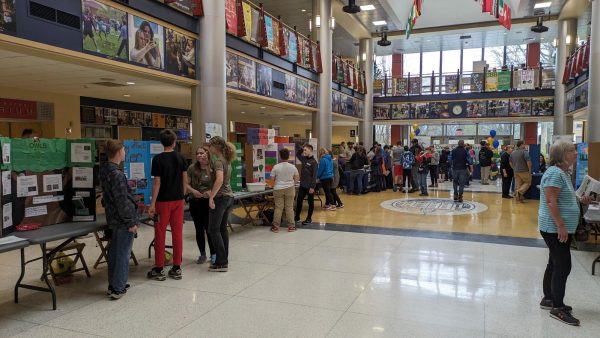Alumnus blends cosmic, music in Allegheny lecture
“Prima Vista: Sight-reading a cosmic symphony in gravitational waves,” a public lunch talk held at 12:15 p.m. Wednesday, Nov. 6, delved into a new technology used to detect gravitational waves. Allegheny alumni and visiting scholar Alex Urban, ’10, explained how LIGO observatories are helping scientists observe the universe.
LIGO stands for “Laser Interferometer Gravitational-Wave Observatory.” LIGO observatories use lasers to detect gravitational waves in space.
“There are some things that you cannot see with classical telescopes,” Urban said. “There is a wealth of new information that we are learning about, like how massive stars form and how they die. This is a big piece of the puzzle that we never had before.”
Before LIGO, scientists mostly relied on electromagnetic radiation to study the universe, which included visible light, X-rays and radio waves. Instead of using visual cues, LIGO is “listening” for gravitational waves to study the universe.
Urban described the state of astronomy before LIGO technology as trying to find a friend in a crowded room.
“Hearing in this setting is much more powerful than seeing,” Urban said.
There are two LIGO observatories in the United States, one in Livingston, Louisiana, and one in Hanford, Washington. These observatories are shaped like an “L,” with two, 2.5-mile long arms that serve to detect the waves.
“Because gravity is very weak, these waves are really, really tiny,” Urban said. “The reason LIGO has to be so huge is because we are looking for really tiny things.”
Gravitational waves are disturbances of spacetime created by violent and energetic processes of the universe. To picture this, Urban said gravitational waves are “kind of like skipping a rock across a pond.”
Hearing in this setting is much more powerful than seeing.
— Alex Urban, Class of 2010
When someone skips a rock across a pond, the rock hits the surface of the pond, and it creates ripples, which spread out faster and faster. Urban said this idea is similar to what gravitational waves are like. The surface of the pond is like space and time, and these ripples are gravitational waves.
After giving background about LIGO and gravitational waves, Urban delved a bit deeper into sound and its characteristics like frequency, pitch and timbre. These characteristics are important when looking at LIGO data because they provide specific information about astronomical events.
When comparing an event like a black hole merger to a neutron star merger, one can quickly detect the difference between the two by looking at the intensity of sound, with frequency being the y-axis and time being the x-axis.
“If you’re looking on the time axis, you can see that there is a tempo to this,” Urban said. “These chords or patterns reoccur with a sort of frequency, or a rhythm. On the frequency axis, you can kind of tell what notes are being heard. We are doing the same game with gravitational waves, with the time axis showing how long the wave takes to merge, and the frequency axis showing what pitch is being heard.”
Black hole mergers are much faster than neutron star mergers, making the difference between the data very obvious to spot when looking at a graph. Neutron star mergers also have a distinct pitch pattern compared to a black hole merger.
Along with the physics majors and faculty, students and faculty of the music department were also present at the lunch talk. Mitch Lachat, ’20, a physics and math double major who is an active participant in choir, said he attended the talk for a few reasons.
“I do work in astrophysics,” Lachat said. “My (Senior Comprehensive Project) is on something similar to black hole mergers. I thought the talk was really cool because he was able to take the physics I enjoy doing and bringing it back to one of my hobbies.”
Chair of the Physics Department and Professor of Physics James Lombardi said there was a great cross section in the audience between the Music Department and the Physics Department.
“The fact that we got people here, I think, shows there is a lot of interest and that we could have collaborations going forward where we tie together music and science,” Lombardi said.
Urban was a student of Lombardi’s when he attended Allegheny. Lombardi said he had a sense of pride seeing former students become as successful as Urban.
“I enjoyed the talk because science is often thought of as this real cut and dry thing, but it’s not at all (that way),” Lombardi said. “Science is exciting. He was connecting the study of gravitational waves with the study of sound. It makes the subject more relatable.”
Urban will potentially be teaching a special topics course next semester. The overall goal of the course is to examine black hole astrophysics.
There will be no homework or graded exams, but rather open discussions and computational modeling.
“The students in the Physics Department are very excited about this,” Lombardi said. “We’re going this afternoon to submit a proposal to the curriculum committee. We are hopeful that they will realize this is a great opportunity for our students.”






